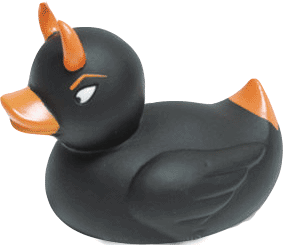In one word: THINK!
Dave Thomas gave an amusing keynote, with a great, clear visual style that’s all the rage in geekland: little text, large fonts and beautiful images. He also had some nice effects: scrolling code, pages that looked as if they fell over. One sentence seemed reluctant to appear. Dave had to encourage it a bit. I’m not a fan of presentation effects (probably because I’m unable to do them well), but these effects worked. Enough about form, on to substance. Dave talked about “Cargo Cults” and “Angry Monkeys”.
Cargo Cult stands for every situation where we blindly copy something, without understanding it, to get some positive effect that we’ve observed. Angry Monkeys stands for every situation where we blindly do something, without understanding it, to avoid a negative effect that we’ve experienced.
 Dave gave several examples of both systemic problems, reflecting his interests and preferences: real object orientation, dynamic typing, agile processes… He could have put up just one slide with, in big friendly letters: “THINK!”. But that wouldn’t have been as much fun.
Dave gave several examples of both systemic problems, reflecting his interests and preferences: real object orientation, dynamic typing, agile processes… He could have put up just one slide with, in big friendly letters: “THINK!”. But that wouldn’t have been as much fun.
There is only one practice
What came out of this keynote tied in with what Norm Kerth told us: perform regular retrospectives to improve your team, your practices, your process(es) and your process-changing process.
Hansei. Kaizen.
Evolution at work
Some of what Dave said resonated with Richard Dawkins‘ writing on evolution:
- You can’t capture everything in a taxonomy. There are no species; no classes. There are only individuals with sets of genes; objects with state and behaviour. Some of those individuals/objects are so similar that you can lump them together, but you’ll always encounter Duck-billed Platypuses.
- Evolution is a powerful tool. Luckily for us, we don’t have to wait millenia, we can guide evolution. Sometimes, we even succeed in improving the system, as we learn more. But, in the end, it’s always the world that decides if we are fit enough to pass on our genes.
During the train journey back to London, Duncan Pierce suggested that agile metrics should measure the “fitness criterion” of our process.
Tags: Systems Thinking, agile, SPA 2006



